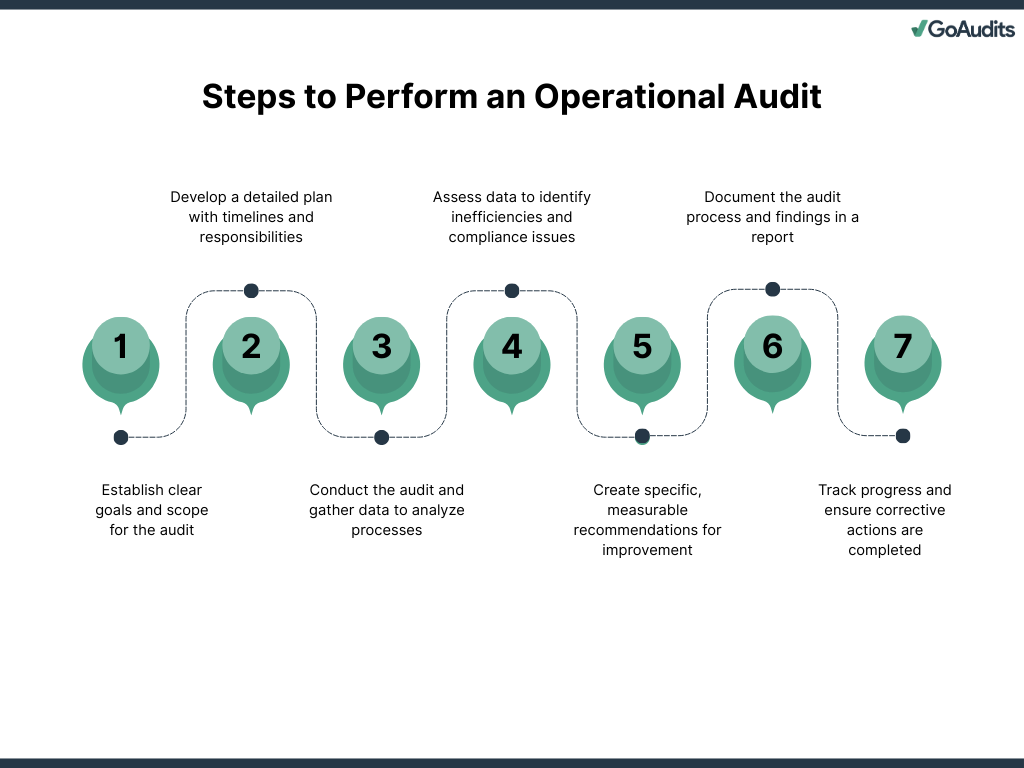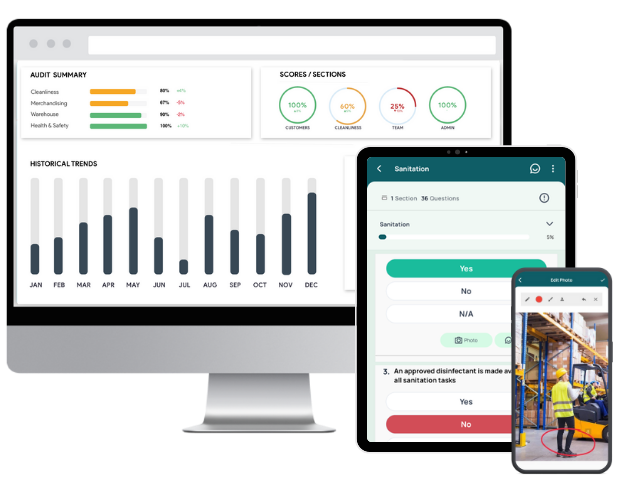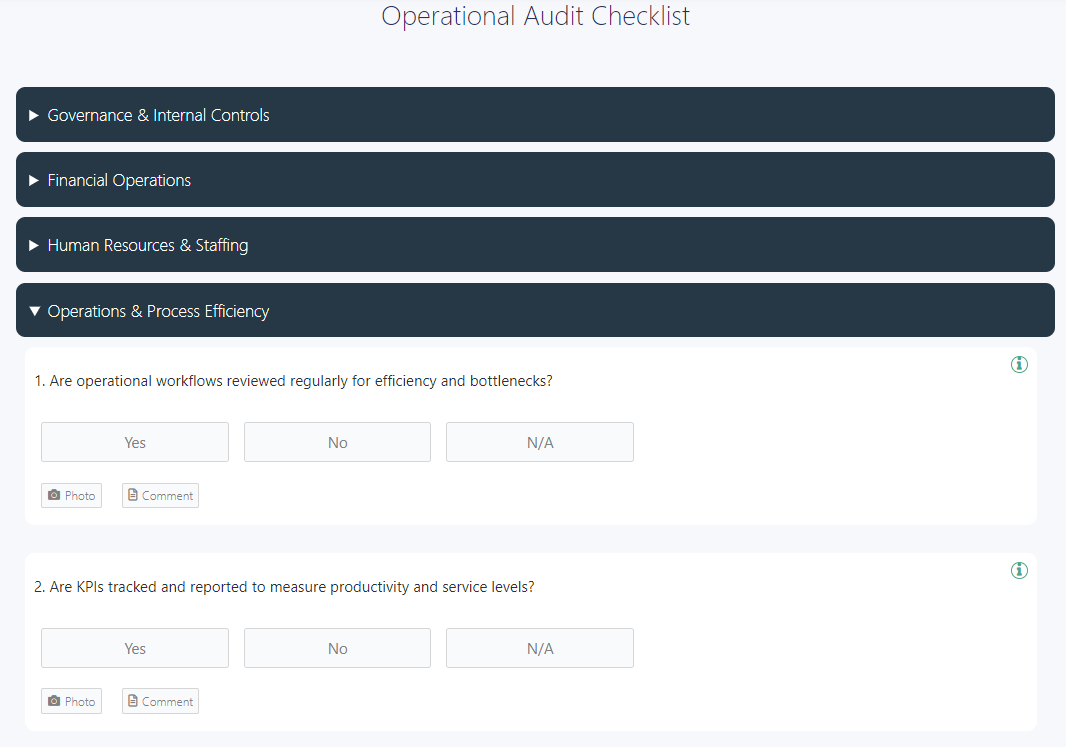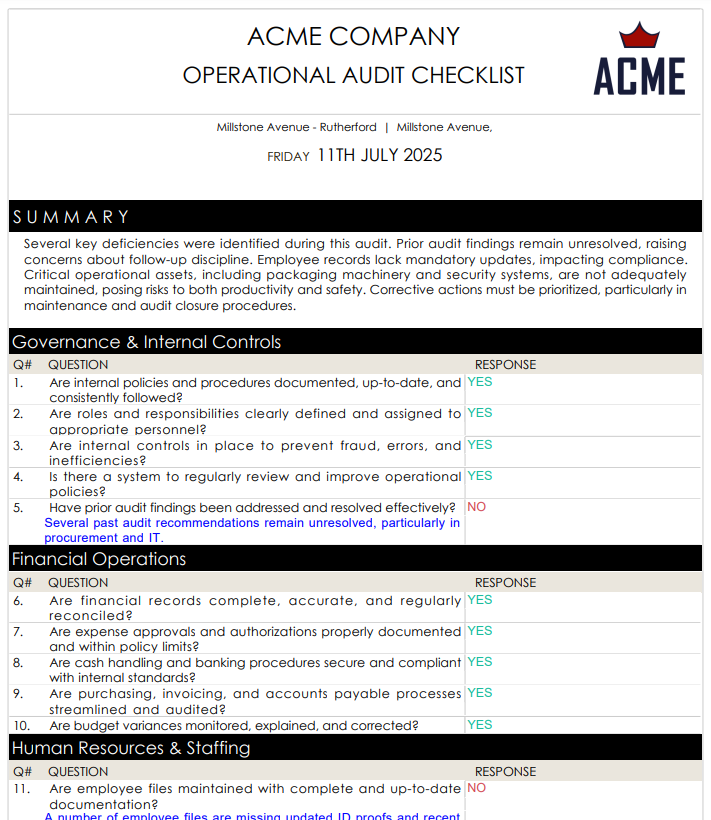Operational audits are a great tool to see how well an organization’s daily operations line up with its goals. By taking an honest look at routine processes, they reveal wasted effort, weak controls, and missed compliance issues that might slip under the radar. Whether you’re in manufacturing, healthcare, finance, or retail, an operational audit keeps everyday tasks on track with strategic objectives. The results raise accountability, sharpen risk management, and give leaders clear data they can act on. In a business world that changes fast and faces growing rules, regular operational audits are one of the best tools for staying efficient and resilient.
In this article, we’ll cover the main types of operational audits, how they differ from internal audits, the steps involved, and how the right operational audit software can make the whole process easier.
- What is an Operational Audit?
- Operational Audit Examples & Types
- Operational Audit vs Internal Audits
- Operational Audit Process: A Step-by-Step Guide
- Free Operational Audit Report Sample
- Operational Audit Software: Key to Efficient Operational Audits
- Operational Audit Reports: What Are They and How to Prepare Them
- How to Prepare an Operational Audit Report?
- FAQs
What is an Operational Audit?
Operational audits are systematic, comprehensive evaluations of an organization’s internal processes, management practices, and operational activities aimed at assessing their effectiveness, efficiency, and economy in achieving organizational goals.
The main objective is to identify areas where resources may be underutilized or mismanaged to improve productivity, reduce waste, and enhance decision-making. Operating audits involve examining workflows, systems, and procedures to provide insights into whether current operations align with strategic goals and highlight inefficiencies, bottlenecks, and compliance gaps.
The three main phases of an operational audit are:
1. Planning: This phase involves defining the audit’s scope and objectives, assessing risks, identifying resources, and developing an audit approach. Auditors notify the client, discuss the scope with management, gather preliminary information, and establish how testing will be conducted. Risk assessment and prioritization are key activities.
2. Fieldwork: Auditors collect and analyze data such as financial records, documents, and information from interviews and observations. The goal is to test controls and procedures, verify that processes are operating as intended, and evaluate the adequacy of internal controls. It includes executing audit procedures and testing to gather persuasive, objective evidence.
3. Reporting: Auditors present their findings, conclusions, and recommendations for improvement. The report highlights issues, informs management of risks or inefficiencies, and provides a basis for corrective actions. It ensures that management understands the audit results and can take appropriate steps.
What is the Purpose of Operational Audits?
- It helps you determine whether resources are being used optimally and identify bottlenecks, redundancies, or underutilized assets. It reveals areas where performance can be improved, enabling you to streamline workflows, reduce waste, and increase productivity.
- Operational audits evaluate whether these controls are well-designed and functioning as intended. When weaknesses are identified, corrective actions can be taken to reduce the risk of errors, fraud, or non-compliance.
- Every organization faces operational risks. Operational audits uncover vulnerabilities and emerging threats. This enables you to proactively address risks before they escalate, supporting a more resilient business framework.
- Operational audits provide fact-based insights derived from detailed analysis of processes, performance metrics, and internal controls. It helps you identify what’s working efficiently and what needs adjustment. You can make informed strategic decisions based on real operational performance rather than assumptions or outdated practices.
- An operational audit verifies that teams are adhering to organizational policies and procedures. Non-compliance often indicates deeper issues such as a lack of training or ineffective communication, which the audit brings to light for timely resolution.
- Operational audits create a structured feedback mechanism that ensures improvements are not one-time efforts but part of an ongoing process. It allows your organization to adapt, correct, and optimize operations continuously.
Operational Audit Examples & Types
Operational audits help you evaluate how efficiently and effectively an organization operates. These audits go beyond financial records and examine procedures, systems, and performance. Understanding the types of operational audits enables you to identify gaps, improve compliance, and drive strategic improvements.
1. Compliance Audits
Compliance audits assess whether operations follow applicable laws, regulations, policies, and standards. You use these audits to verify adherence to industry-specific rules or internal company policies. Non-compliance findings often lead to corrective action and risk mitigation strategies.
Compliance audits can be of different types, depending on the industry a business operates in. Here are some of the most common ones:
Health and safety audits are used to assess whether workplace conditions comply with OSHA standards and internal safety policies. They typically include inspections of personal protective equipment, fire safety systems, emergency action and response plans, and incident reporting protocols.
👉 Free Resources
GoAudits offers ready-to-use and customizable health and safety audit checklists to help you streamline inspections, covering essential areas like workplace hazards, employee safety practices, equipment condition, and emergency preparedness. Some examples include:
→ Near Miss Incident Report
→ Fire Safety Inspection Checklist
→ PPE Inspection Checklists
→ OHS Inspection Checklists
→ OSHA Checklists & Templates
Food safety & hygiene audits are essential for restaurants, food manufacturing, and hospitality. They evaluate compliance with HACCP, cleanliness standards, local health department regulations, and global food safety standards. Checks may include kitchen sanitation, personal hygiene, equipment maintenance, food storage temperatures, and pest control.
👉 Free Resources
GoAudits offers a wide range of restaurant and food safety audit checklists. You can sign up for free and start using these checklists, or you can even digitize your food SOPs into actionable checklists.
→ Food Safety Checklists & Audit Templates
→ HACCP-Based SOP Templates
→ Opening and Closing Checklist for Restaurants
→ BRC Audit Checklists
→ GMP Audit Checklist
Environmental compliance audits are conducted in industries like manufacturing, construction, and utilities. They review waste management practices, emissions control, hazardous material handling, and compliance with environmental laws like the EPA regulations.
👉 GoAudits offers a free environmental audit checklist and an environmental inspection checklist, specifically designed for environmental compliance audits, supporting proactive risk management and sustainable operational practices.
Retail audits ensure that retail outlets comply with brand guidelines and operational policies. They cover visual merchandising, pricing accuracy, promotional displays, cleanliness, and staff presentation across locations.
👉 Free Resources
GoAudits offers free retail store audit checklists specifically designed to support retail standard audits and ensure consistency, quality, and compliance across your retail locations.
→ Merchandising Audit Checklist
→ Product Inspection Checklist
→ Retail Store Mystery Shopper Checklist
→ Retail Store Opening & Closing Checklists
ISO compliance audits are used across sectors to ensure compliance with ISO standards such as ISO 9001, ISO 14001, ISO 45001, ISO 50001, and many more. These ISO audits involve documentation reviews, process checks, and performance evaluations.
👉 Free Resources
GoAudits ISO compliance software offers an extensive library of free ISO audit checklists to perform ISO compliance audits across different industries.
→ ISO 22000 Food Safety Checklist (FSMS)
→ ISO 9001 2015 Audit Checklist
→ ISO 14001 Internal Audit Checklist
→ ISO 45001 Audit Checklist
→ ISO 50001 Internal Audit Checklist
Clinical or healthcare compliance audits are crucial in healthcare settings. They verify that clinical operations follow medical protocols and legal regulations, such as those defined by HIPAA or local health authorities. They may include patient record handling, infection control, and staff training and development.
👉 Free Resources
You can explore GoAudits’ library of free healthcare compliance checklists to perform clinical and regulatory audits, meet healthcare compliance standards, and provide high-quality care.
→ Medical Record Audit Checklist
→ HIPAA Compliance Checklist
→ Care Home Audit Checklist
→ CQC Inspection Checklist
→ QAPI Plan Template
Supply chain audits evaluate vendor and supplier practices against contracts, sustainability standards, or social responsibility guidelines. They may assess ethical sourcing, safety protocols, and environmental compliance.
👉 Free Resources
GoAudits offers a wide range of free logistics and supply chain audit checklists to ensure safety, efficiency, and regulatory compliance across your logistics and supply chain operations.
→ Logistics Audit Checklist
→ Supply Chain Audit Checklist
→ General Warehouse Inspection Template
→ Pre-Shipment Inspection Checklist
2. Financial Audits
Financial audits focus on the accuracy and integrity of financial records within operational processes. These audits help you confirm whether financial data reflects actual performance and complies with accounting standards. They’re essential for identifying misstatements, misallocations, or financial control weaknesses.
3. Departmental Audits
Departmental audits evaluate the efficiency and effectiveness of specific departments, such as HR, procurement, or logistics. You gain insights into departmental processes, resource use, and internal controls. These operational audits support better decision-making at the unit level and promote accountability.
4. Functional Audits
Functional audits examine specific business functions, like payroll, inventory management, or customer service, across departments. These audits let you evaluate how well a function performs organization-wide, helping to streamline processes and eliminate redundancies.
5. IT Audits
IT audits review your organization’s information systems, cybersecurity controls, and data management practices. They assess whether IT assets are safeguarded, data is reliable, and systems support business objectives. These audits are vital for reducing data breaches and ensuring regulatory compliance.
👉 For a step-by-step approach to information security audits, read our detailed blog on ISO 27001 audit, and use this ISO 27001 checklist to simplify compliance and strengthen your ISMS.
6. Investigative Audits
Investigative audits are initiated when there’s suspicion of fraud, misconduct, or irregularities. These audits are detailed and often confidential. You use them to uncover evidence, identify responsible parties, and support legal or disciplinary actions.
7. Follow-up Audits
Follow-up audits check whether previously identified issues have been addressed effectively. You assess the implementation of corrective actions and determine if controls now function as intended. They ensure accountability and continuous improvement.
👉 An operational audit app & software can help you establish an operational improvement loop: manage corrective actions and follow-up audits more efficiently, ensure that your team is accountable, and prevent issues from being forgotten.
8. Performance Audits
Performance audits evaluate how well resources are used to achieve objectives. You analyze processes for economy, efficiency, and effectiveness. They offer strategic insights and recommend changes that enhance operational performance and cost-effectiveness.
9. Management Audits
Management audits focus on evaluating leadership practices, decision-making processes, and organizational structure. They help you identify leadership gaps, assess strategic alignment, and improve overall governance. Management audits support long-term organizational health.
10. Quality Audits
Quality audits assess adherence to quality standards in processes, products, or services. You use them to ensure compliance with ISO or internal quality frameworks. Quality audits drive customer satisfaction and help sustain continuous improvement in output quality.
👉 Digitising your quality audits doesn’t have to be a lengthy, complex process. Check out the GoAudits quality control app and free quality control checklists to bring significant efficiencies and improve your quality control processes.
Operational Audit vs Internal Audits
Understanding the differences between an operational audit and internal audits is essential for improving business performance and ensuring regulatory compliance. While both audits aim to enhance organizational effectiveness, they differ significantly in scope, objectives, execution, and evaluation criteria.
Scope and Objective
Operational audit focuses on evaluating the efficiency, effectiveness, and economy of business operations. It aims to assess whether resources are being used optimally and if processes align with strategic goals. The primary objective is performance improvement rather than compliance.
Internal audits have a broader scope, encompassing risk management, internal controls, financial reporting, and compliance with laws and policies. The objective is to provide independent assurance that risk management, control, and governance systems are functioning as intended.
Who Conducts Them and When
Operational audits are typically conducted by internal auditors with expertise in business processes. They may also involve external consultants for specialized reviews. They are performed periodically or when management identifies a need to optimize specific functions, such as procurement or supply chain management.
Internal auditors within the organization carry out internal audits on a recurring schedule, often driven by a risk-based audit plan approved by the audit committee. They are continuous and cyclical, covering all aspects of the organization over time.
Reporting
Operational audit reports are usually presented to department heads and senior management. The findings focus on identifying inefficiencies, recommending process improvements, and outlining action plans. Emphasis is placed on adding value through strategic insights.
Internal audit reports are submitted to top management and the audit committee. They include observations on internal controls, compliance gaps, risk exposures, and recommendations for corrective actions. Internal audit reports are more formal.
Criteria That Determine Successful Outcomes
Operational audit’s success is measured by improvements in performance indicators such as cost savings, process cycle times, productivity gains, and enhanced resource utilization. A successful operational audit leads to measurable enhancements in business outcomes.
Internal audit’s success depends on the identification and mitigation of risks, compliance with policies and regulations, improved internal controls, and strengthened governance practices. A successful internal audit contributes to organizational integrity and long-term sustainability.
| Aspect | Operational Audit | Internal Audit |
| Scope | Focuses on operational efficiency, effectiveness, and economy. | Covers risk management, internal controls, compliance, and governance. |
| Objective | Aims to improve business performance and resource utilization. | Aims to ensure systems and controls are functioning as intended. |
| Who Conducts Them | Conducted by internal auditors or external experts with operational expertise. | Conducted by internal auditors, often part of a dedicated internal audit department. |
| When are they conducted | Performed periodically or when improvement opportunities are identified. | Performed regularly based on a risk-based audit plan. |
| Reporting | Reports are shared with department heads and senior management. It emphasizes actionable recommendations to enhance operations. | Reports are submitted to top management and the audit committee. It focuses on control gaps, risk exposure, and compliance issues. |
| Success Criteria | Measured by operational improvements: cost savings, efficiency gains, and productivity. | Measured by risk mitigation, compliance, improved controls, and stronger governance. |
Operational Audit Process: A Step-by-Step Guide
To ensure your audit delivers real value, follow a systematic, step-by-step approach.
1. Define Objectives and Scope
Start by clearly outlining the audit’s objectives. What do you want to achieve? Your goals could include reducing operational costs, enhancing productivity, or improving risk management. Once you establish objectives, define the scope. Identify the departments, processes, or functions to be audited. Limit the scope to areas with the highest impact or risk, ensuring a focused and manageable audit.
2. Prepare an Operational Audit Plan
With objectives and scope in place, develop a detailed audit plan. This plan should include:
- Timeline and milestones
- Key personnel and responsibilities
- Audit criteria and benchmarks
- Data sources and documentation needed
An effective operational plan sets expectations and provides a roadmap for the audit team.
3. Conduct the Audit and Collect Data
Now, execute the audit. Collect data through document reviews, process walkthroughs, interviews, and direct observations. Analyze the workflows, resource usage, decision-making processes, and control mechanisms. Identify inefficiencies, redundancies, bottlenecks, or deviations from standard procedures. Use quantitative and qualitative data to assess performance against defined benchmarks.
👉 You can use this free operational audit checklist to perform an operational audit, assess different processes, comply with internal policies, and identify and address inefficiencies.
4. Evaluate Findings
After collecting the data, assess the findings. Focus on:
- Process effectiveness
- Operational efficiency
- Internal control adequacy
- Compliance with policies and regulations
Rank the findings by severity and impact. This helps prioritize corrective actions and communicate the results more effectively to stakeholders.
5. Develop Actionable Recommendations for Improvement
Translate the findings into practical, result-oriented recommendations. Ensure each recommendation is specific, measurable, achievable, relevant, and time-bound (SMART). Recommendations should focus on eliminating inefficiencies, enhancing controls, and improving overall process performance.
6. Prepare a Formal Operational Audit Report
Document the entire audit process in a structured report. Include:
- Objectives and scope
- Methodology
- Key findings
- Root cause analysis
- Recommendations
- Risk implications
Use clear headings, bullet points, and visuals to enhance readability. Tailor the report to your audience, ensuring it supports informed decision-making.
👉 Producing professional-looking audit reports doesn’t have to be a painful, lengthy process. You can easily automate operational audit reporting with a simple auditing app.
7. Follow Up and Monitor
Establish a follow-up mechanism to track the status of each recommendation. Monitor progress regularly and ensure corrective actions are completed effectively. Provide updates to management and revise the action plan if required.

Free Operational Audit Report Sample
Here’s an operational audit report sample generated using GoAudits:
Operational Audit Software: Key to Efficient Operational Audits
A user-friendly digital tool will save you time and effort, helping you collect and analyze data across every location. GoAudits is an operational audit app and software that enables teams to conduct audits anytime, anywhere, and take immediate corrective action based on real-time data. Whether you’re in manufacturing, retail, hospitality, or healthcare, GoAudits helps you identify inefficiencies, ensure accountability, and stay compliant.

- Access ready-made, best-practice audit templates tailored for different industries. Easily customize or create your own checklists using a drag-and-drop interface. Send in your current forms, and we’ll digitize them at no extra cost.
- Conduct operational audits offline or online using any device. Attach photos, capture signatures, and log timestamps with geolocation.
- Automatically generate branded, professional reports right after an audit. Include visual evidence, scores, timestamps, and assigned actions. Customize layouts and cover pages to reflect your brand and reporting standards.
- Assign corrective actions with due dates and priorities during the audit. Track task progress, get overdue alerts, and maintain strong accountability.
- Set up rules and workflows for audit approvals, escalations, and follow-ups. Automatically notify the right people via email with direct access to reports.
- Monitor performance and compliance trends across all sites. Spot recurring issues and high-risk areas using smart scoring and historical data. Use real-time dashboards to view audit results, task statuses, and upcoming inspections.
Operational Audit Reports: What Are They and How to Prepare Them
Operational audit reports are formal documents produced after conducting an operational audit, which is a systematic and comprehensive evaluation of an organization’s internal operations, processes, and controls. These reports provide detailed insights into how effectively and efficiently a company is managing its resources, adhering to policies, and achieving its objectives.
Why Do You Need an Operational Audit Report?
Here’s why it matters:
- It provides a transparent and factual record of observations, ensuring that decision-makers have actionable insights and can prioritize corrective actions with precision. It outlines inefficiencies, control weaknesses, and areas of improvement in a structured format.
- It establishes a measurable reference point and supports continuous improvement by making performance trends and operational shifts more visible over time. It helps you compare current operations against best practices and past performance.
- By presenting objective findings and standardized metrics, the report fosters interdepartmental understanding. It aligns diverse teams with common goals, clarifies responsibilities, and supports cohesive decision-making across operational functions.
- Operational audit reports provide data-backed insights that inform strategic decisions. They reveal operational strengths and weaknesses, enabling leadership to allocate resources effectively, streamline operations, and set realistic long-term goals.
- It acts as documented evidence of due diligence. It supports internal governance and helps you demonstrate compliance with industry regulations, legal requirements, and internal policies, especially during external audits or regulatory reviews.
- It assigns clear ownership for issues and improvements. By highlighting responsibilities and documenting progress, it encourages accountability at all organizational levels. This promotes a culture of transparency and continuous performance enhancement.
How to Prepare an Operational Audit Report?
Follow these steps to create a professional and actionable report:
Gather All the Relevant Information
Start by collecting comprehensive data. Review internal documents, policies, procedures, past audit reports, and performance metrics. Interview relevant personnel and observe operations to validate the accuracy of the documented processes. Ensure that the data covers all departments or functions under review. This foundation is critical to support your analysis and recommendations.
Use a Structured Format to Draft the Report
Present the information in a logical, easy-to-follow format. Begin with an executive summary outlining the audit scope, objectives, and a brief overview of the findings. Follow this with sections such as methodology, observations, risk assessment, and recommendations. Consistency in structure allows readers to scan and understand key points quickly.
List Key Findings and Issues
Clearly highlight significant findings, categorized by risk level or functional area. Address deviations from policies, control weaknesses, inefficiencies, or compliance gaps. Use bullet points or tables for clarity and impact. Support each issue with evidence and explain the potential consequences if left unresolved.
Review and Share with Management
Before finalizing the report, perform a thorough review for accuracy, completeness, and objectivity. Eliminate vague statements and ensure each point is backed by data. Once reviewed internally, share the report with management. Present it in a meeting where findings can be discussed, and feedback can be gathered. This helps align expectations and paves the way for corrective actions.
Use Operational Audit Software for Efficiency
Leverage operational audit software to streamline the process. These tools help automate data collection, risk scoring, documentation, and report generation. Software solutions also enhance collaboration, version control, and audit trail management, improving both accuracy and efficiency.
FAQs
The 8 Es of operational auditing: Economy, Efficiency, Effectiveness, Ethics, Environment, Equity, Execution, and Evaluation. These act as a framework for assessing organizational performance beyond financial compliance. Economy examines cost minimization without compromising quality. Efficiency measures how well resources are used. Effectiveness focuses on achieving intended outcomes. Ethics ensures integrity and transparency. Environment considers sustainability practices. Equity evaluates fairness in service delivery. Execution reviews the implementation of plans and policies. Evaluation involves continuous performance monitoring and improvement.
A compliance audit focuses on verifying adherence to laws, regulations, and internal policies, ensuring that all processes conform strictly to prescribed standards. It is rule-based and often mandated by regulatory authorities. In contrast, an operational audit evaluates the efficiency, effectiveness, and economy of business operations. Rather than just checking for rule-following, it aims to identify opportunities for performance improvement and resource optimization.
A performance audit broadly assesses whether programs or functions meet their goals effectively, efficiently, and with accountability, often focusing on public sector entities. It emphasizes outcomes and value for money. An operational audit, while also concerned with efficiency and effectiveness, takes a closer look at internal processes, resource utilization, and control systems within an organization. It is more internally focused and continuous in nature, offering practical insights for management improvement.






